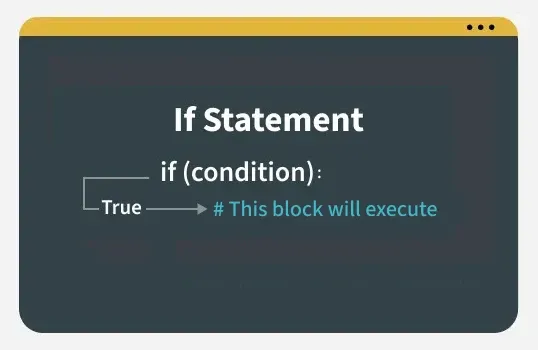Conditional statements in Python are used to control the flow of a program by executing different blocks of code based on specific conditions.
They help your program “make decisions” — just like humans do.

For example:
age = 18
if age >= 18:
print("Eligible to vote")
Python’s conditional statements are widely used for:
a. Decision Making — To execute certain code only if a condition is met.
b. Validation — To verify user inputs like login credentials.
c. Program Control — To control loops or terminate code early based on conditions.
d. Dynamic Output — To produce different results based on inputs or data.
A. if Statement
The if statement is used to execute a block of code only if the given condition is True.

Syntax:
if condition:
statement(s)
Example:
num = 10
if num > 0:
print("Positive number")
B. if...else Statement
This statement executes one block if the condition is True, and another block if it is False.
Syntax:
if condition:
statement(s) when True
else:
statement(s) when False
Example:
age = int(input("Enter your age: "))
if age >= 18:
print("You are an adult.")
else:
print("You are a minor.")
C. if...elif...else Ladder
When you have multiple conditions, use elif (short for else if).

Syntax:
if condition1:
statement1
elif condition2:
statement2
elif condition3:
statement3
else:
statementN
Example:
marks = int(input("Enter your marks: "))
if marks >= 90:
print("Grade A")
elif marks >= 75:
print("Grade B")
elif marks >= 50:
print("Grade C")
else:
print("Fail")
D. Nested if Statement
An if statement can exist inside another if statement.
This is useful when multiple layers of conditions are needed.
Example:
num = int(input("Enter a number: "))
if num >= 0:
if num == 0:
print("Number is Zero")
else:
print("Number is Positive")
else:
print("Number is Negative")
You can combine multiple conditions using logical operators.
| Operator | Meaning | Example |
|---|---|---|
| and | True if both conditions are true | age > 18 and city == "Delhi" |
| or | True if at least one is true | marks > 90 or grade == "A" |
| not | Reverses the condition | not(is_raining) |
Example:
age = 25
city = "Dehradun"
if age > 18 and city == "Dehradun":
print("Eligible for registration")
For simple one-line conditions, Python allows a short-hand syntax.
Example:
x = 5
if x > 0: print("Positive")
Short-hand if...else:
x = -3
print("Positive") if x > 0 else print("Negative")
🧮 Example 1: Even or Odd
num = int(input("Enter a number: "))
if num % 2 == 0:
print("Even number")
else:
print("Odd number")
💰 Example 2: Simple Tax Calculator
income = float(input("Enter your income: "))
if income <= 250000:
print("No tax")
elif income <= 500000:
print("5% tax")
elif income <= 1000000:
print("20% tax")
else:
print("30% tax")
🧑🎓 Example 3: Student Result
marks = int(input("Enter marks: "))
if marks >= 90:
print("Excellent")
elif marks >= 75:
print("Very Good")
elif marks >= 50:
print("Pass")
else:
print("Fail")
Positive-Negative-Zero Checker
→ Take an integer input and print whether it’s positive, negative, or zero.
Leap Year Checker
→ Input a year and check if it’s a leap year using nested if.
Largest of Three Numbers
→ Take three numbers and print which one is the largest.
Login System (Basic)
→ Input username & password, and check if they match stored values.



